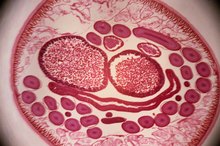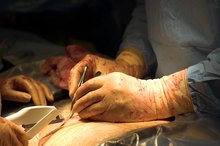Symptoms of a Staph Infection After Surgery
Staphylococcus aureus, which is a bacteria commonly referred to as "staph," is a common organism that lives on the skin but can cause infection if it gets into the body through an incision or wound. Staph infections that develop after surgery can be caused by poor hygiene of medical personnel or the patient; contamination of equipment or devices used during the surgery; or contact with visitors or patients who also are infected.
Digestive Problems
Digestive problems after surgery may be a symptom of a staph infection, according to the Mayo Clinic. Vomiting and feelings of nausea after surgery may result from toxic shock syndrome, which is a serious complication caused by widespread staph infection. People who have a feeding tube implanted after surgery have a greater risk of getting staph infections as a result of contamination of the tube.
Fever
Symptoms of Roundworms in People
Learn More
According to the Mayo Clinic, fever after surgery is a symptom of staph infection. A fever that persists after a surgical procedure is a sign that staph is in the bloodstream, which is a serious condition that may become life-threatening. Fevers after surgery may be accompanied by other infection symptoms, including chills, shivering or sweating.
Internal Damage
According to the Centers for Disease Control and Prevention, damage to the body's internal organs is a symptom of staph infections after surgery. Staph may get into internal organs after surgery, including the heart and lungs, and cause damage to the valves and muscles. The bones can become infected with staph, and staph that spreads throughout the blood can cause a condition called sepsis, which is life-threatening.
Leakage
Post Hemorrhoidectomy Complications
Learn More
Leakage of surgical wounds is a symptom of staph infections after surgery, according to the Mayo Clinic. The incision may leak pus, which may appear white or yellow and may have a strong or bad smell. The leakage from the surgical site may contain the staph bacteria, which can then infect others who clean the wound or come into contact with linens or clothing, if they do not follow proper infection control procedures.
Pain
Pain in the skin or tissue around the surgical site is a symptom of staph infection, according to the Mayo Clinic. Staph infections may begin with symptoms such as mild tenderness around the wound or incision. If the infection is left untreated or is resistant to antibiotic treatments, pain can get worse as the infection spreads into deeper tissue and muscle.
Skin Changes
Skin changes around the surgical site are common symptoms of staph infections after surgery, according to the Mayo Clinic. Skin around the incision may develop a rash or bumps and appear red, raw and swollen. The surgical site may feel warm to the touch and look lumpy or rippled due to staph infections.
Related Articles
References
Resources
Writer Bio
Jessica Lietz has been writing about health-related topics since 2009. She has several years of experience in genetics research, survey design, analysis and epidemiology, working on both infectious and chronic diseases. Lietz holds a Master of Public Health in epidemiology from The Ohio State University.









